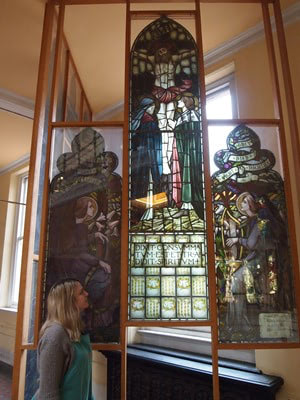Part of Birmingham Museums Trust, Birmingham Museum & Art Gallery (BMAG) is home to the largest public Pre-Raphaelite collection in the world, numbering over 3000 paintings, drawings, prints and examples of decorative art and design.
Toward the end of 2019, BMAG is scheduled to close for refurbishment for a number of years. In advance of this closure, a selection of some of the finest works from the Pre-Raphaelite collection will travel in a touring exhibition that will visit a number of U.S. museums, giving our collection exposure to new audiences while our building undergoes redevelopment.
This complex touring exhibition project, led by Victoria Osborne, Fine Art Curator, has been a number of years in development and co-organised with the American Federation of Arts (AFA).
On the conservation side, the project has been led largely by Lizzie Miller, Objects Conservator. The selection of objects was mixed, and included works on paper, paintings, stained glass, and 3D objects.
The conservation work began back in January 2016, with a preliminary condition survey of the objects. The survey form captured key data on the objects, including dimensions, materials, hazards, framing information where applicable, condition information, and an estimate of treatment requirements and costs, so that the budget could be prioritised according to need and urgency of treatments.

One of the driving factors behind the refurbishment of BMAG is the poor circulation within the building, including the conservation studios that are not readily serviced by lift access. This meant there was no way of bringing larger objects into the studio for conservation. Necessity was, however, turned to opportunity, and one of the smaller galleries was converted into a temporary studio, making it possible to undertake the conservation work of large objects, such as the cassoné, in view of the public.

External specialists were brought in to support the conservation programme. The object list for the touring exhibition includes a number of large stained glass pieces that have not travelled. A stained glass conservator undertook repairs to the glass, including the provision of handling frames, and created light-boxes that could travel with the handling frames. This not only makes installation easier, but limits the handling required of the fragile stained glass. Conservation work by a paintings conservator removed darkened varnish on the early Edward Burne-Jones’s Annunciation (1857), revealing the vibrant original colours that had been hidden for decades.

While we had considered the possibility of opening up the collection to new audiences, one of the more interesting learnings from the project was taking new physical geographies into account. Our original approach to object mounting was based on our own institutional practice – in other words, the (English) West Midlands are not known for seismic activity, while some of the hosting venues are. We had not considered this, and when the venues became known we had to somewhat re-think our approach, and become au fait with seismic mounts, and re-visit the approach to object mounting.
Following a trial of Optium a few years previous, we specified Optium for the framing and glazing of the paintings that were to travel, including the largest painting – at approximately 6 feet (1.75m) high and 8 feet (2.5m) wide, titled ‘Pandora Crowned by the Seasons’. The use of Optium ensures that the paintings are adequately protected with anti-reflective glazing, without adding significant additional weight or risk of breakage that would come from laminated glass, both key concerns for works that travel.

The assiduous preparation of the collection means that we have successfully sent off our show. While tinged with sadness at saying goodbye to some of our Pre-Raphaelite friends, we look forward to the audiences they will greet as they begin their U.S. tour.
Share this Article:
This article is intended for educational purposes only and does not replace independent professional judgment. Statements of fact and opinions expressed are those of the author(s) individually and, unless expressly stated to the contrary, are not the opinion or position of Tru Vue or its employees. Tru Vue does not endorse or approve, and assumes no responsibility for, the content, accuracy or completeness of the information presented.
